Stocks, Commodites and Bond Inter-Market Relationships
Stock-Markets / Financial Markets 2009 Nov 29, 2009 - 07:46 PM GMT Ten Year Yields have been tracking in the same direction as stocks for years – until this summer. Now they are moving in opposite directions. What gives?
Ten Year Yields have been tracking in the same direction as stocks for years – until this summer. Now they are moving in opposite directions. What gives?

This inverse tracking of stocks and rates has only been going on for a few months, and that isn’t long enough to confirm a change in trend, at least not yet. It is, however, a warning flag worth paying attention to, especially if it continues on its present course. Something doesn’t seem right.

Here’s the anomaly or conundrum; or whatever else you may wish to call these varying inter-market relationships. There are a couple of different “parts” or “issues” to discuss.
First, as the chart above shows, 10 year Treasury yields and stocks have parted company since summer: they are no longer moving in the same direction, but inversely to one another.
Second, as was shown in last week’s report, the yield curve is steepening: the difference between short term and long term rates is increasing. Short term rates are near zero – the absurd zero interest rate policy first put into play by the Japanese. Now, the U.S. is following suit – in spades.
In other words, it is the fact that short term rates have fallen so low that the yield curve has steepened, not that long term rates are taking off higher; in fact, long term rates have been falling, but short term rates have been falling faster. The chart below shows the drop in 90 day T-bill yields, while stocks are rising.
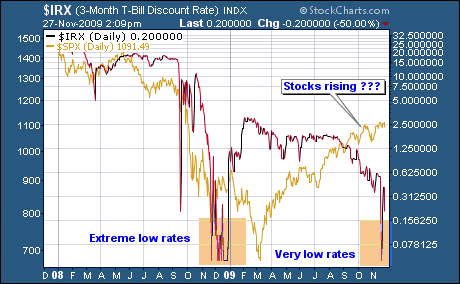
A question that should be on investor’s minds is: why are so many players willing to get almost no return (interest) on T-bills, while at the same time the stock market is steadily moving higher? What are investors afraid of? The return of money is trumping the return on money. That is a sure sign that something is wrong.
The stock market is predicting that all is well with the economy. That’s not what T-bill rates are saying. One of the two is wrong. There are some other “conundrums” as well: for instance: T-bonds are advancing, while inflation protected bonds (TIP’s) are advancing, and gold is advancing. All three cannot be right. Is there inflation or isn’t there?
Bonds
Up first is a daily chart comparing interest rates (TNX) to bond prices (TLT). Yields and bond prices move inversely (opposite) to one another.
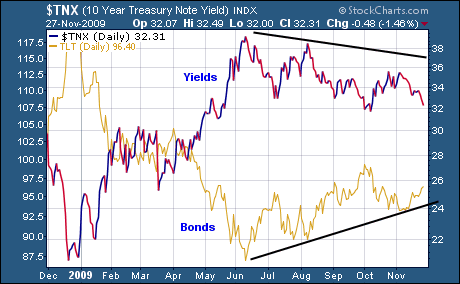
The 10 Year T-note has been moving opposite to stocks until recently. Can bonds & stocks continue to move higher together? Will one change direction?
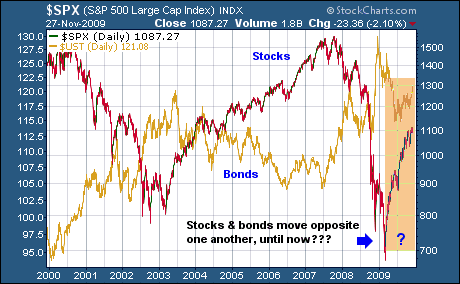
The 30 year long bond is rising, meaning long term rates are moving down. The yield curve has been steepening because short term rates have been falling faster than long term rates; but both have been falling – short term rates precipitously so.
As evidenced by the chart below, the 30-Year bond held support from Oct. – Nov. and has now broken out above resistance. Friday saw a gap up that is testing the Oct. high.
This is an important development, as stocks and bonds do not normally trend in the same direction; suggesting that one may be due for a change of direction. One thing is for sure: interest rates will determine which way bonds move. So, interest rates hold the key. But there are mixed signals here as well, as we will soon see.
Stocks and bonds are having a bit of inter-market disagreement, as are stocks and short term T-bill rates. With the Dubai news, the picture is becoming a bit clearer. A flight to perceived safe havens appears to be underway; or perhaps to liquid markets is a better choice of terms.
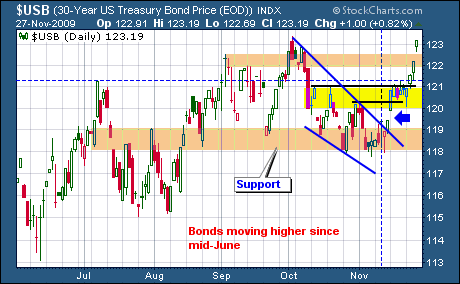
One final anomaly is offered. We have seen that bond prices are rising, while interest rates are falling; however, inflation indexed bonds (TIP’s) are also rising, and rising in lock step with gold.
Apparently, someone expects inflation to pick up, at least those buying inflation indexed bonds do. So, why are others buying regular bonds that are loathe to inflation, while, at the same time gold is hitting all-time highs?
In other words: either TIP’s or regular T-bonds are wrong; either interest rates or stocks are wrong; either bonds or stocks are wrong; and perhaps the dollar or short term rates are about to come to blows?
The only other possible explanation is that we are truly entering a new world order where long held inter-market relationships no longer apply.
Lots of questions to be answered, so stay tuned. We do live in fascinating times. It’s hard to be bored with all that’s going on.
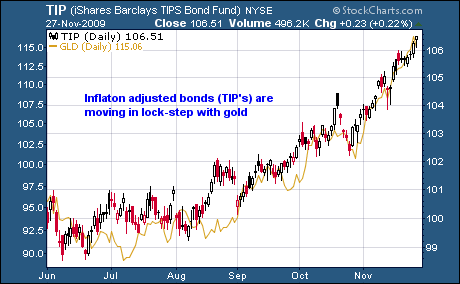
Silver
Silver did not fare as well as gold this past week, as it lost -1.14%, to close at $18.29 (continuous contract). As mentioned in last week’s report, the narrowing triangle formation suggests that a big move is coming one way or the other, as price action is becoming more “compressed”.
Price is sitting just above support at $18, which was broken through intra-day and then regained. The yellow band represents short term support. The 50 ma is converging on the bottom trend line.
The RSI and MACD divergences mentioned last week still obtain, and a negative MACD crossover occurred: based on shorter ma parameters as indicated.

The above excerpt is a small sampling from the latest full-length market wrap report, available only at the Honest Money Gold & Silver Report website. All major markets are covered with the emphasis on the precious metals.
Stop by and see what the risk to reward ratio on gold is saying and whether now is a good or dangerous time to be buying gold and silver stocks. For a free trial subscription email a request to dvg6@comcast.net.
Good luck. Good trading. Good health, and that’s a wrap.

Come visit our website: Honest Money Gold & Silver Report
New Audio-Book Now Available - Honest Money
Douglas V. Gnazzo
Honest Money Gold & Silver Report
About the author: Douglas V. Gnazzo writes for numerous websites and his work appears both here and abroad. Mr. Gnazzo is a listed scholar for the Foundation for the Advancement of Monetary Education (FAME).
Disclaimer: The contents of this article represent the opinions of Douglas V. Gnazzo. Nothing contained herein is intended as investment advice or recommendations for specific investment decisions, and you should not rely on it as such. Douglas V. Gnazzo is not a registered investment advisor. Information and analysis above are derived from sources and using methods believed to be reliable, but Douglas. V. Gnazzo cannot accept responsibility for any trading losses you may incur as a result of your reliance on this analysis and will not be held liable for the consequence of reliance upon any opinion or statement contained herein or any omission. Individuals should consult with their broker and personal financial advisors before engaging in any trading activities. Do your own due diligence regarding personal investment decisions. This article may contain information that is confidential and/or protected by law. The purpose of this article is intended to be used as an educational discussion of the issues involved. Douglas V. Gnazzo is not a lawyer or a legal scholar. Information and analysis derived from the quoted sources are believed to be reliable and are offered in good faith. Only a highly trained and certified and registered legal professional should be regarded as an authority on the issues involved; and all those seeking such an authoritative opinion should do their own due diligence and seek out the advice of a legal professional. Lastly Douglas V. Gnazzo believes that The United States of America is the greatest country on Earth, but that it can yet become greater. This article is written to help facilitate that greater becoming. God Bless America.

© 2005-2022 http://www.MarketOracle.co.uk - The Market Oracle is a FREE Daily Financial Markets Analysis & Forecasting online publication.



